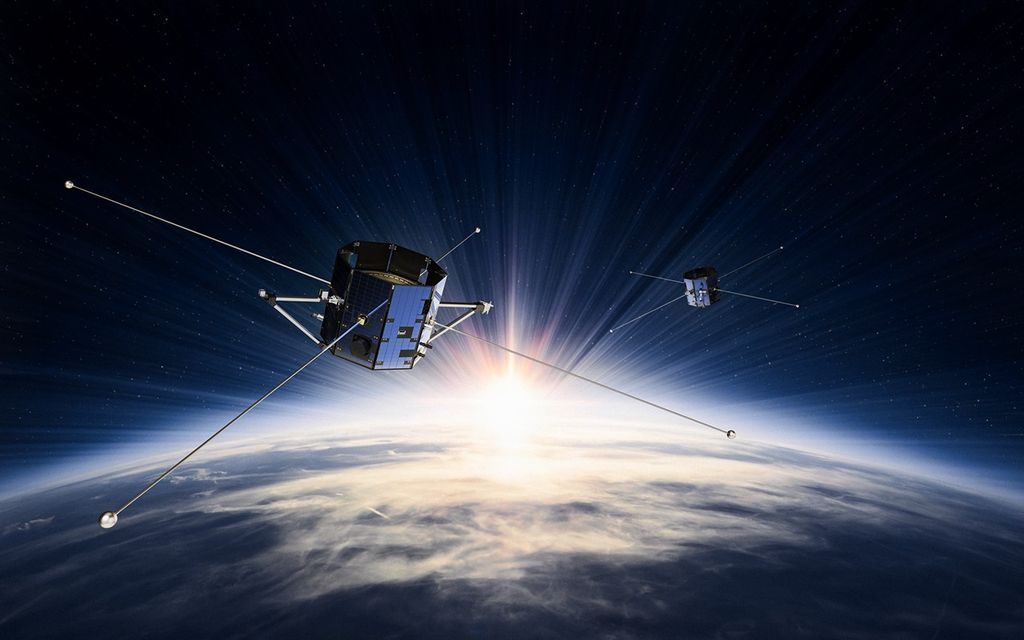The first installment of this series described the Project Management Building from its initial groundbreaking in 1963 through first occupancy in 1964 and some major changes since then, and the term of the center’s first director, Robert R. Gilruth. The primary function of Johnson Space Center’s (JSC) directors has been to lead the world’s premier human spaceflight facility and the civil service and contractor employees who conduct the work of the center on behalf of the agency. Their varied activities have included leading management meetings, greeting astronauts after their return from space, dedicating new facilities, meeting with local politicians, world leaders, and celebrities, and many other tasks to maintain America’s leadership in human spaceflight. The articles in the series provide information about the 13 unique individuals who have led JSC over the past 60 years and continue to lead us into the future of human exploration. This article focuses on the time from the last two Apollo Moon landings through the early years of the space shuttle, to shortly after the Challenger accident, and the three men who led JSC through the of triumphs and the tragedy. For more information about the directors who led first the Manned Spacecraft Center (MSC) and now JSC, please visit Johnson Space Center Directors | NASA.
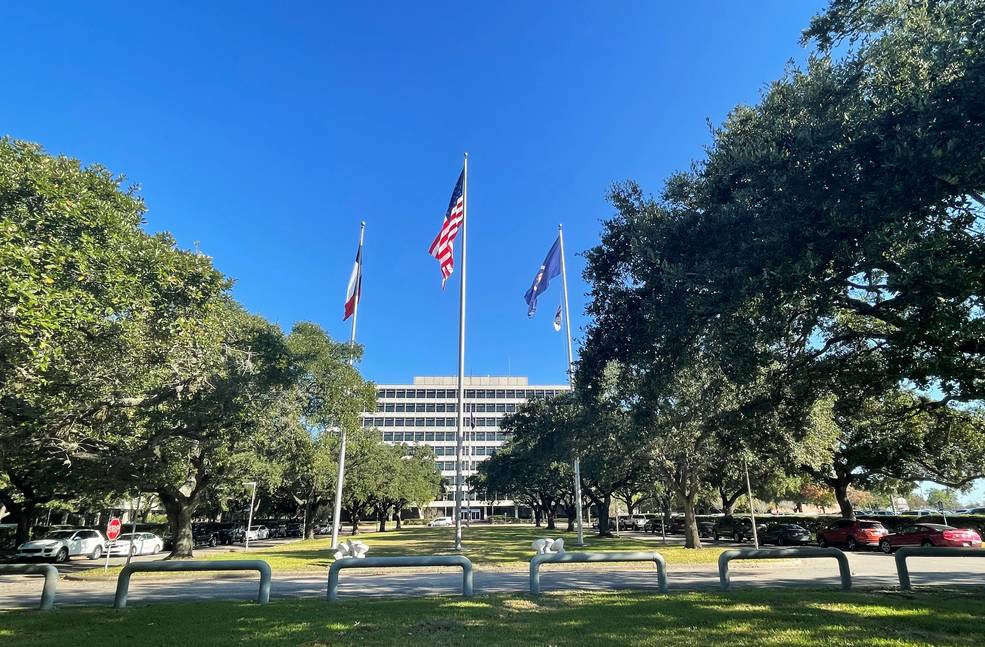
The Project Management Building, known today as Building 1, with its four flagpoles, at NASA’s Johnson Space Center in Houston in November 2021.
Christopher C. Kraft (January 1972 to August 1982)
Christopher C. Kraft began his lengthy public service career in 1944 when he joined the National Advisory Council for Aeronautics (NACA), NASA’s predecessor organization, after graduating from Virginia Polytechnic Institute and State University. After conducting aeronautical research for more than a decade, in 1958 Kraft joined the Space Task Group, the team led by Robert Gilruth within the newly-established NASA, charged with putting the first Americans in space. Kraft developed the concept of mission control, first established in the Mercury Control Center at Cape Canaveral in Florida, and served as the flight director for the Mercury missions. In 1965, control of America’s human spaceflights shifted to the newly-built Mission Control Center (MCC) at MSC in Houston, where Kraft continued to serve as flight director, along with additional flight directors selected to support the longer Gemini missions. In 1968, Kraft retired as a flight director, overseeing the Apollo missions as director of flight operations. Center Director Gilruth named Kraft as his deputy in November 1969, and Kraft succeeded him upon his retirement in January 1972.
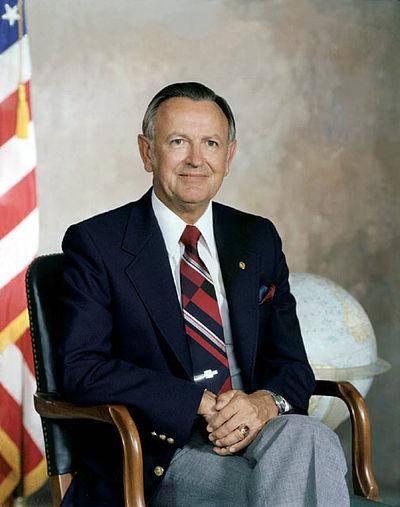
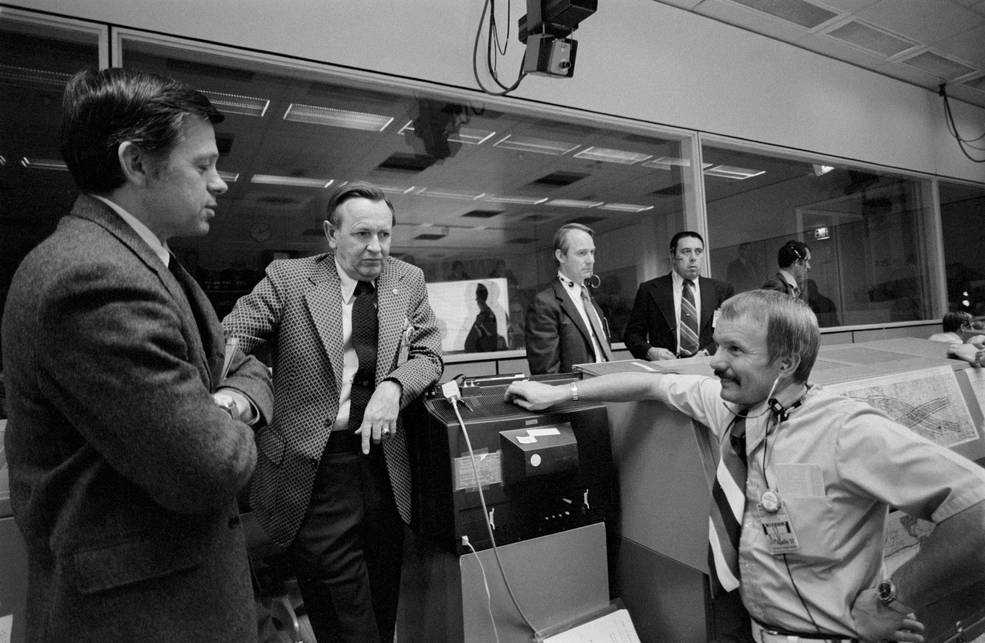
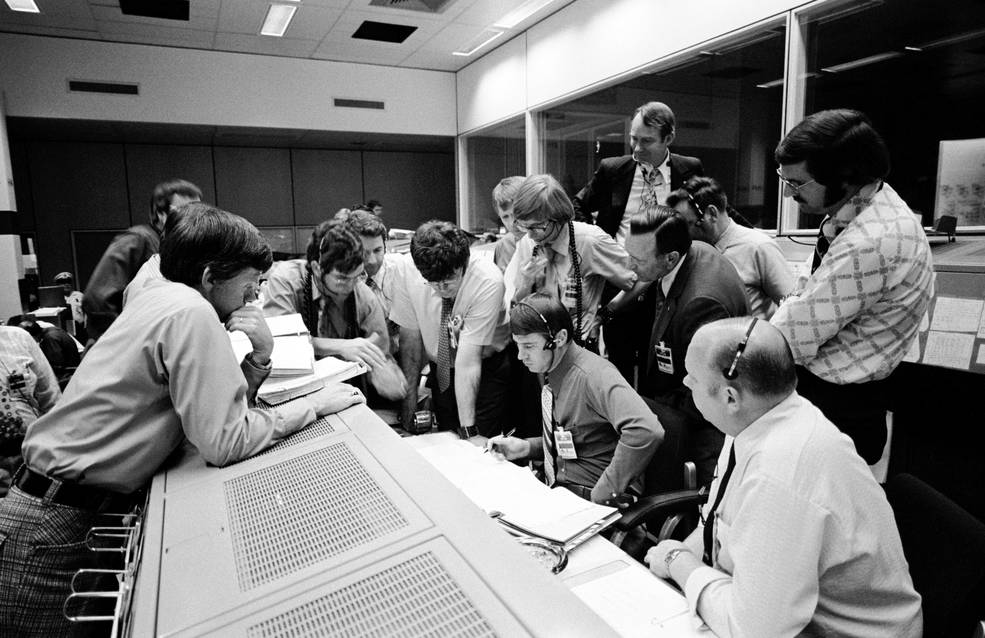
Left: Official portrait of Christopher C. Kraft, the second director of the Manned Spacecraft Center (MSC), now NASA’s Johnson Space Center (JSC) in Houston. Middle: In December 1972, in MSC’s Mission Control Center (MCC), Kraft, second from left, confers with Flight Directors M.P. “Pete” Frank, left, and Gerald R. Griffin, who would succeed Kraft as center director, during the Apollo 17 launch delay, as Kraft’s technical assistant and future center director George W.S. Abbey, at rear right, looks on. Right: In the MCC in May 1973, Kraft, fourth from right, huddling with flight
directors and managers shortly after the Skylab space station suffered damage during its launch.
During his first year as center director, Kraft oversaw the final two Moon landing missions, Apollo 16 and 17, in April and December 1972, respectively, bringing to a close the first period of lunar exploration. The following year saw the launch of the Skylab space station, and although damaged at launch, ground crews put together repair plans that the astronauts implemented that enabled them to set new flight duration records and conduct unprecedented research on the human body, solar physics, and Earth observations. Kraft was still center director when Skylab made an uncontrolled reentry over the Indian Ocean and Australia in July 1979.
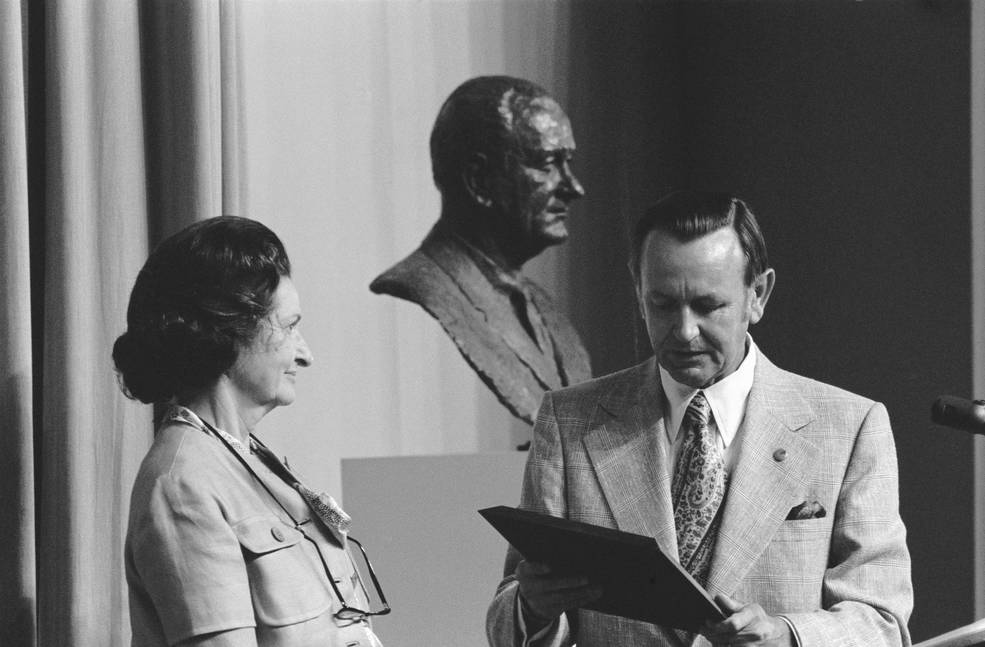
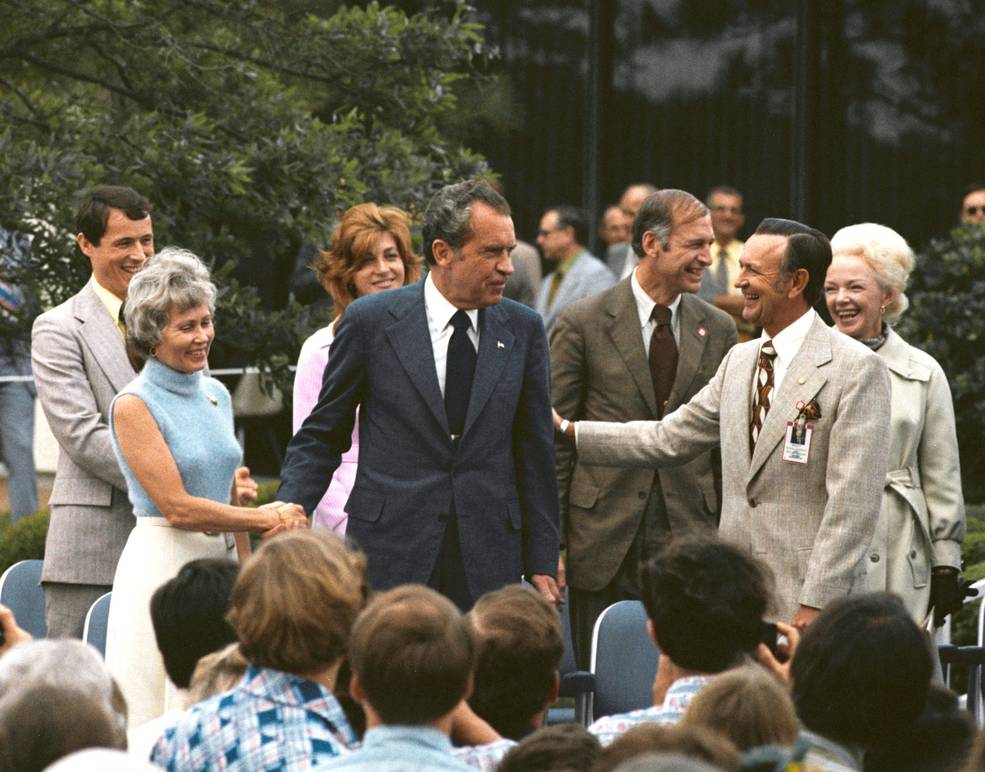
Left: Johnson Space Center (JSC) Director Christopher C. Kraft, right, with the former First Lady, Lady Bird Johnson, at the ceremony renaming the Manned Spacecraft Center after President Lyndon B. Johnson in August 1973. Right: Kraft, right, with President Richard M. Nixon, center, during his visit to JSC to present awards to the Skylab 4 crew in March 1974.
In February 1973, President Richard M. Nixon signed a Senate resolution renaming MSC as NASA’s Lyndon B. Johnson Space Center following the death of President Johnson, who was instrumental in the founding of NASA in 1958 and a strong supporter of the agency and its programs throughout his political career. During a formal dedication ceremony in August 1973, Kraft hosted the former First Lady, Lady Bird Johnson and other family members. In March 1974, Kraft hosted President Nixon during his visit to the center during which the President addressed 5,000 assembled employees and tourists and presented Distinguished Service Medals to the Skylab 4 crew who had recently returned from their 84-day record setting mission aboard America’s first space station.
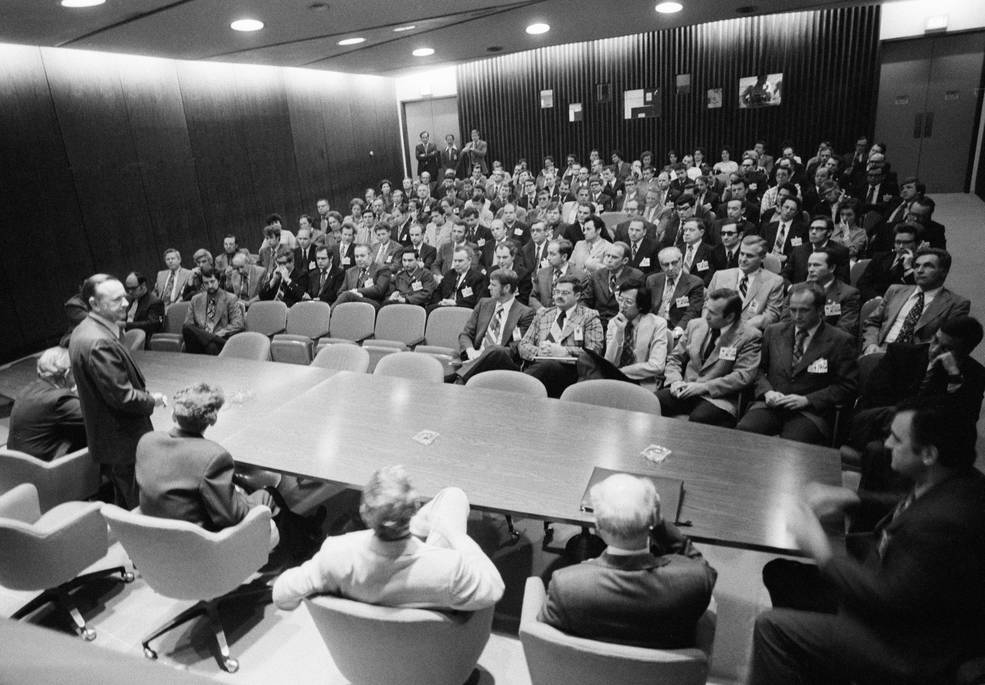
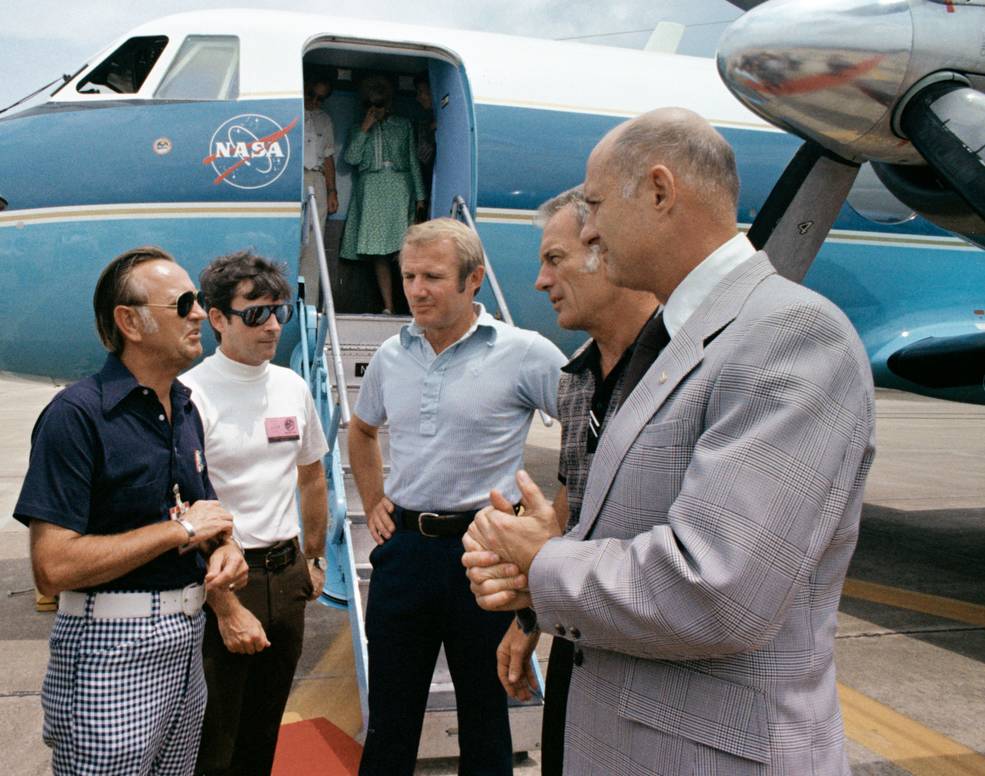
Left: In February 1975, Christopher C. Kraft, director of NASA’s Johnson Space Center (JSC), standing at left, addresses American and Soviet engineers during a joint meeting in preparation for the Apollo-Soyuz Test Project (ASTP). Right: Kraft, left, and astronaut John W. Young welcome home the American ASTP crew of Vance D. Brand, Donald K. “Deke” Slayton, and Thomas P. Stafford at Ellington Air Force Base near JSC in August 1975.
As center director, Kraft played a key role in the development of the Apollo-Soyuz Test Project, the first joint mission between the United States and the Soviet Union. After the formal signing of the agreement at the Moscow Summit in May 1972, JSC hosted several joint meetings and crew training sessions before the July 1975 mission. Kraft met the returning U.S. astronauts at Houston’s Ellington Air Force Base following their historic mission.
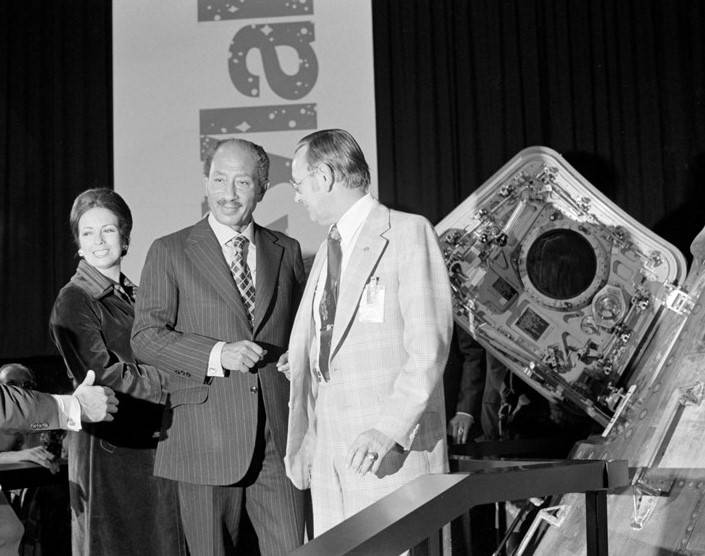
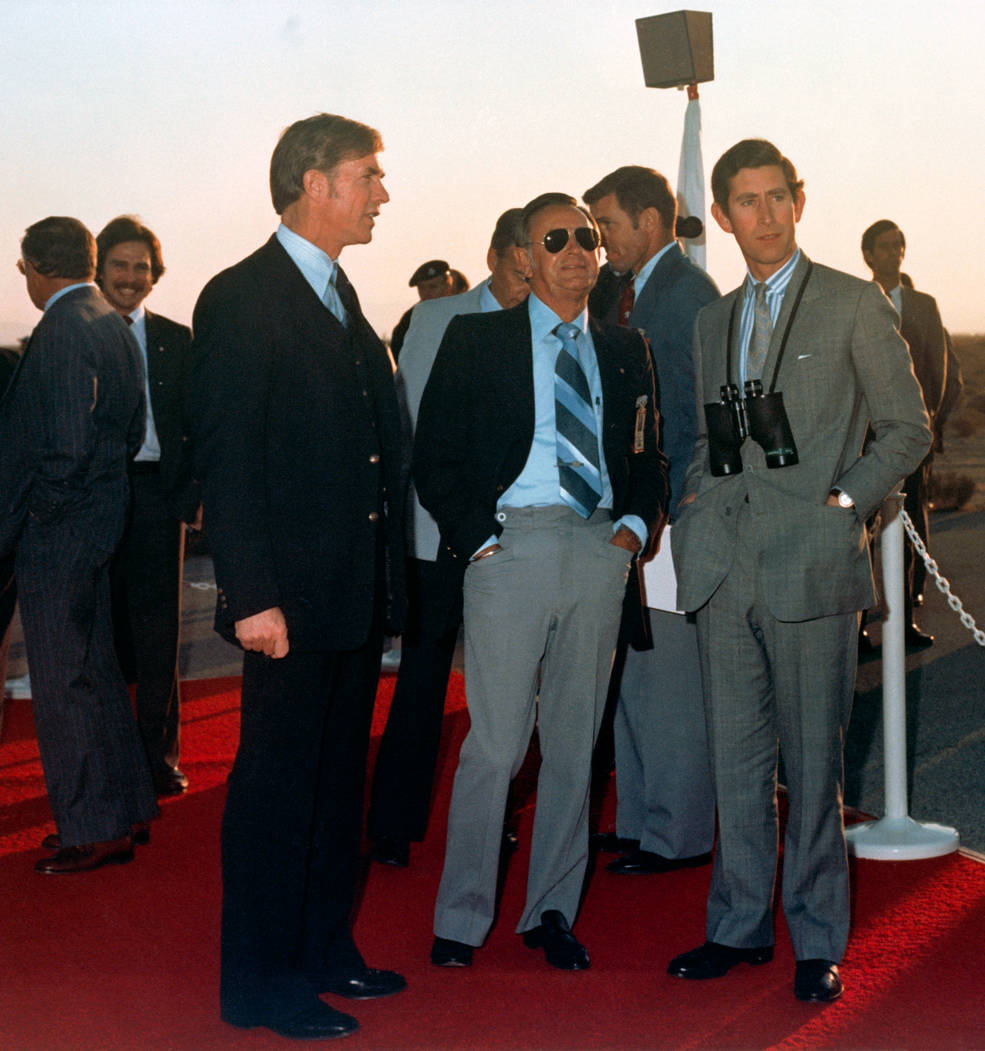
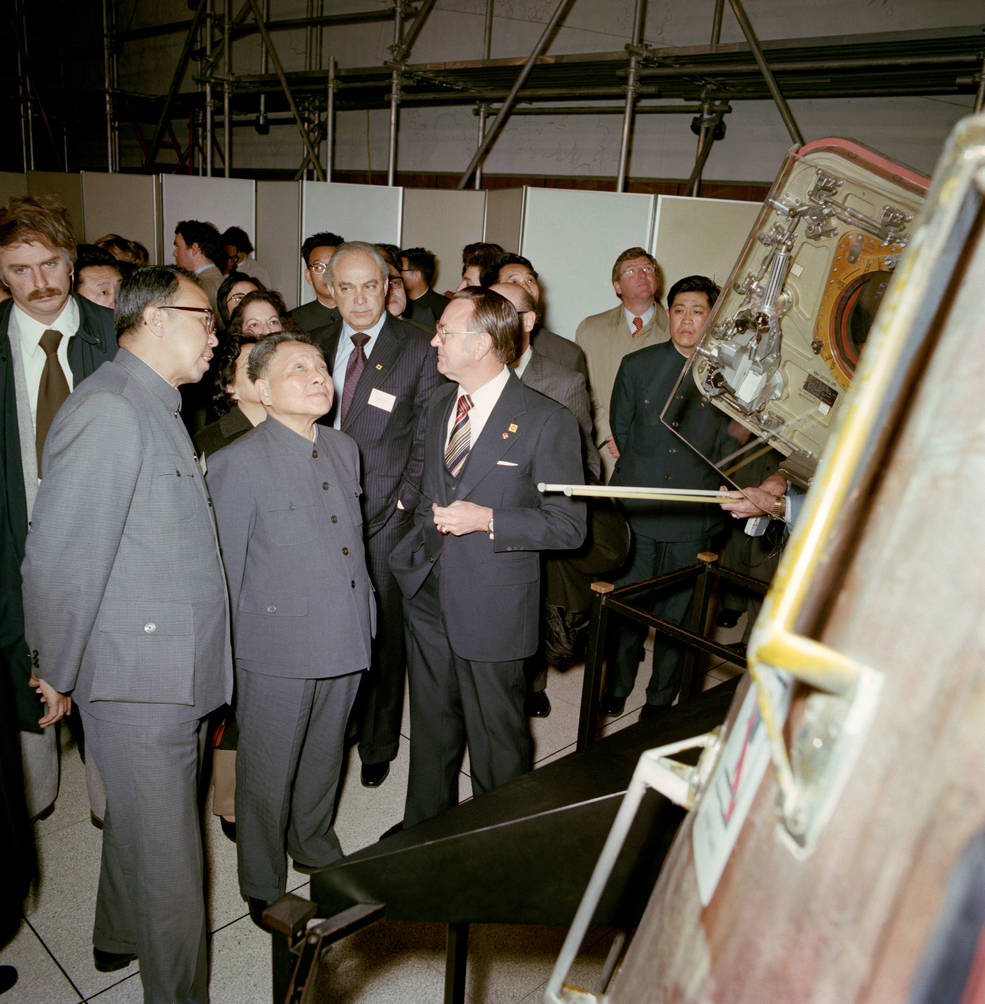
Left: Johnson Space Center (JSC) Director Christopher C. Kraft, right, describes the Apollo 17 Command Module to Egyptian President Anwar el-Sadat and his wife Jehan during their visit to JSC in October 1975. Middle: Kraft, center, with Prince Charles of the United Kingdom, right, and David R. Scott, director of the Dryden Flight Research Center, now NASA’s Armstrong Flight Research Center, at Dryden for space shuttle Enterprise’s fifth and final Approach and Landing Test in October 1977. Right: Kraft showing the Apollo 17 spacecraft to Vice Premier Deng Xiaoping of the People’s Republic of China during his visit to JSC in February 1979.
The varied duties of a center director included hosting visiting foreign dignitaries. In October 1975, Kraft hosted Egyptian President Anwar el-Sadat, his wife Jehan, and their son Gamal, accompanied by Vice President Nelson D. Rockefeller, and described various space artifacts to them, such as the Apollo 17 Command Module America and a model of the Lunar Roving Vehicle. Kraft also provided them with a tour of the Mission Operations Control Room where he previously worked as a flight director. In October 1977, Kraft hosted Prince Charles of the United Kingdom at JSC where His Royal Highness tried his hand at the shuttle simulator and then traveled with him to the Dryden Flight Research Center, now NASA’s Armstrong Flight Research Center, in California, where Dryden Center Director and former astronaut David R. Scott hosted them. They observed the fifth and final Approach and Landing Test of space shuttle Enterprise. Kraft hosted Vice Premier Deng Xiaping of the People’s Republic of China in February 1979, the highest-ranking official from that country to visit JSC. Kraft described several space artifacts to the Vice Premier, who also toured the Skylab trainer and “flew” the shuttle simulator in Building 5.
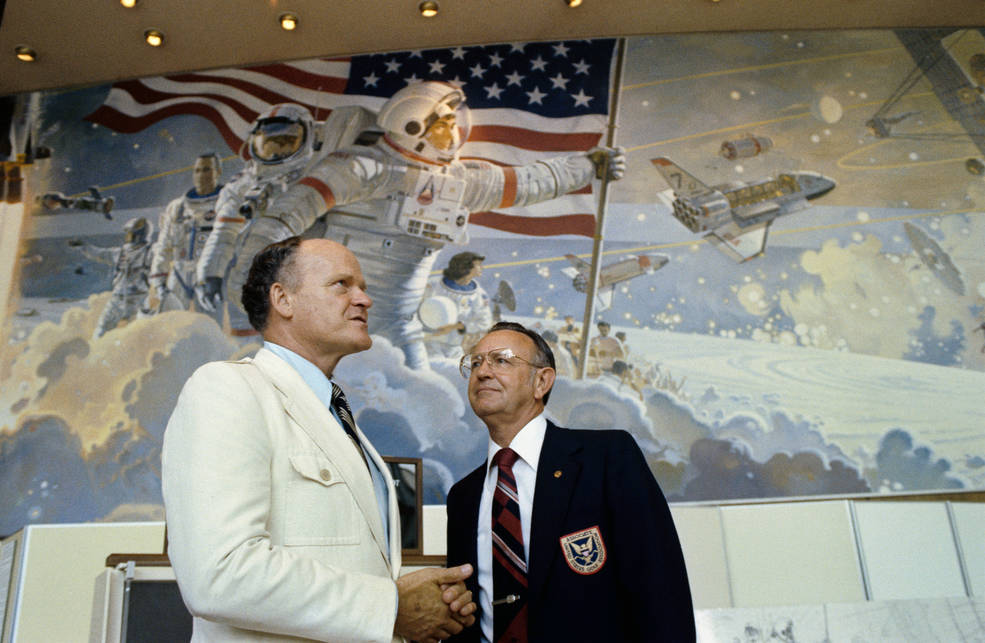
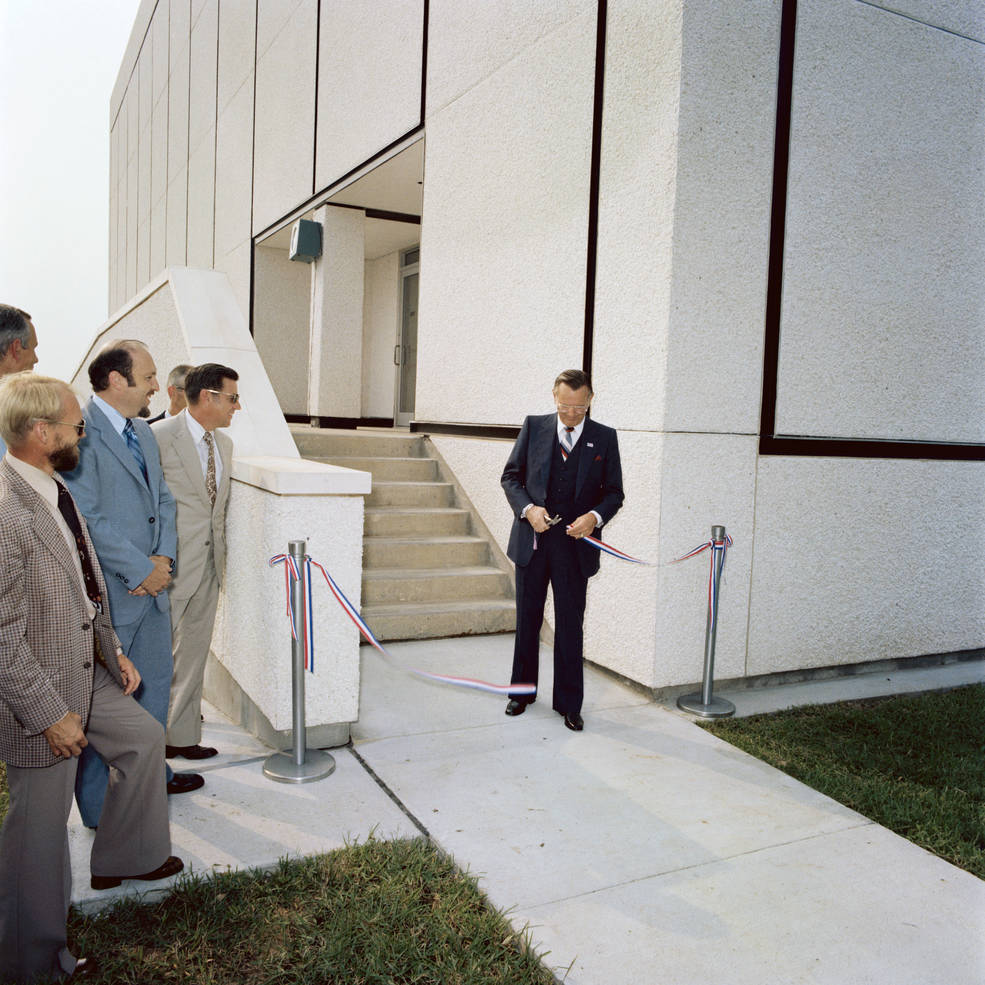
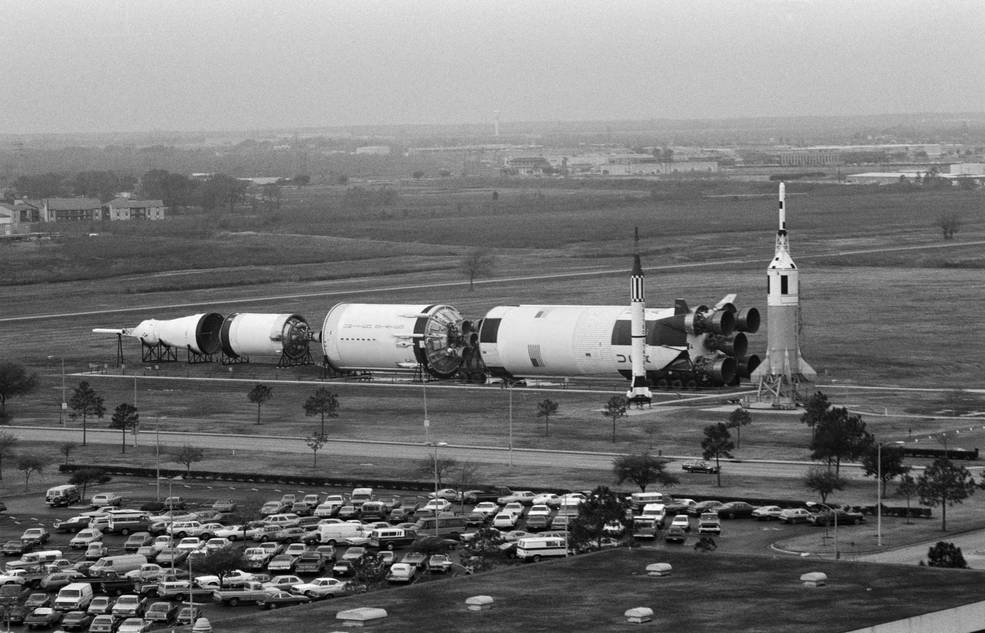
Left: In June 1979, director of NASA’s Johnson Space Center (JSC) in Houston Christopher C. Kraft, right, with space artist Robert T. McCall who painted a mural outside the main auditorium in Building 2. Middle: Kraft cutting the ribbon at the dedication of the Building 31 annex lunar sample curatorial facility in July 1979. Right: Rocket Park in December 1979 as seen from Building 1.
In his role as director, Kraft oversaw the addition of several new buildings and improvements to the center. Under construction since March 1972, the first phase of JSC’s recreation center opened in August 1973. Kraft led the ceremony to dedicate the facility to the center’s first director, Robert Gilruth, who attended the festivities. Although seemingly trivial, the Project Management Building originally known as Building 2, and the Public Affairs and Auditorium Building originally known as Building 1, officially swapped numbers in June 1974. To display large space hardware for public viewing, JSC began construction on the Manned Space Flight Exhibit Complex, now known as the George W.S. Abbey Rocket Park after the former JSC center director, in July 1977. The Apollo Little Joe II and Mercury Redstone rockets went on display first, followed in December by the Saturn V rocket using stages from cancelled Apollo and Skylab missions. Kraft commissioned noted space artist Robert T. McCall to paint a mural on the outside of the center’s main auditorium in Building 2. In 1979, McCall spent several months at JSC painting the mural entitled Opening the Space Frontier – The Next Giant Step, illustrating NASA’s human space flight program, past, present, and future. Dedication of the mural took place on June 19, 1979, and at the time the building housing the auditorium also housed the JSC Visitors Center, allowing the public to view the mural. On July 20, 1979, the 10th anniversary of the first Moon landing, Kraft dedicated the Lunar Sample Facility (Building 31 North) as a permanent storage facility capable of providing a physically secure and non-contaminating environment for the Apollo lunar sample collection. In July 1981, Kraft, accompanied by NASA Administrator James M. Beggs, and led the ceremony at the renaming of the Building 2 Visitors Center and Auditorium after the late Texas Congressman and longtime NASA supporter Olin E. “Tiger” Teague.
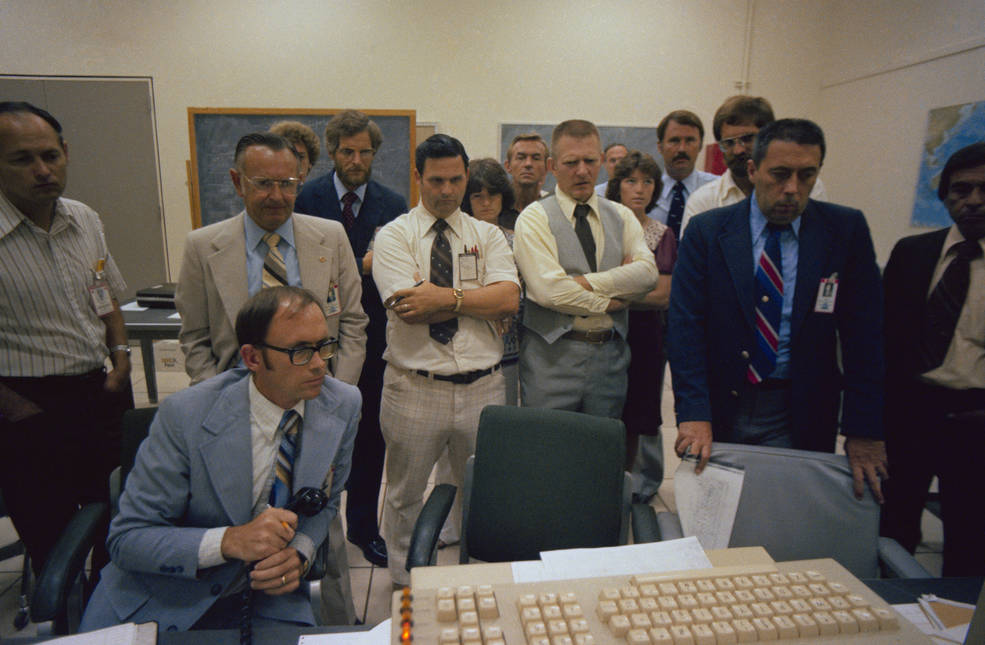
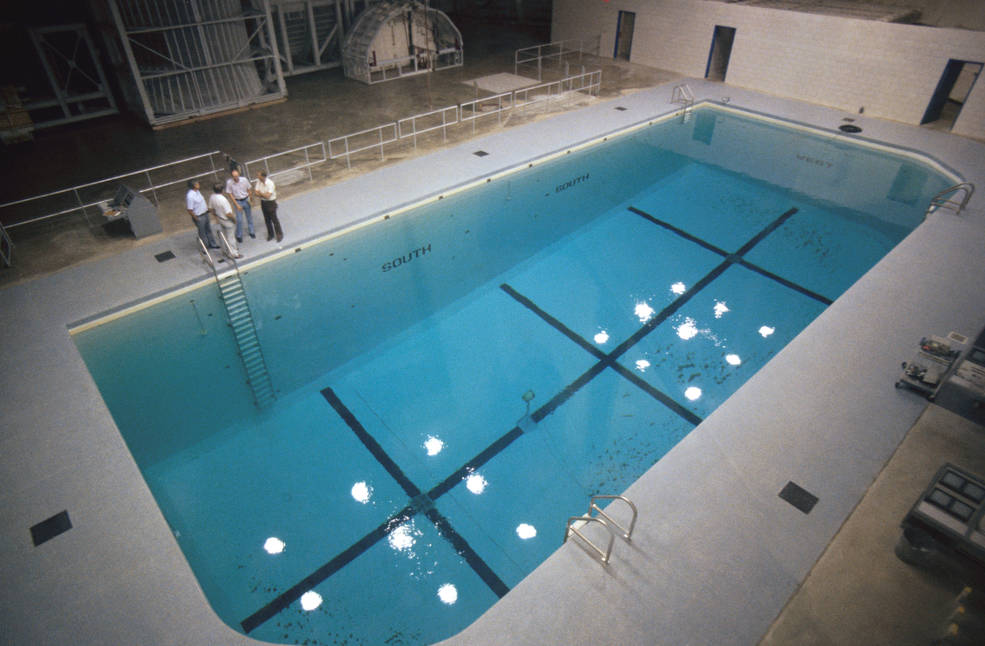
Left: Director of NASA’s Johnson Space Center (JSC) Christopher C. Kraft, standing second from left, monitors the reentry of the Skylab space station in July 1979; director of flight operations and future JSC director George W.S. Abbey is at right. Right: In September 1980, JSC’s nearly complete Weightless Environment Training Facility for training space shuttle astronauts for spacewalks.
During his tenure, Kraft ensured that JSC prepared itself for the space shuttle era, a program President Nixon approved in February 1972 and under development through the 1970s. From a crew training perspective, this included the installation of full-scale shuttle trainers in Building 9’s new wing beginning in 1975, the installation of the first shuttle flight simulator in Building 5 in October 1976, and the construction of a large neutral buoyancy pool called the Weightless Environment Training Facility in Building 29 that became operational in 1980. The MCC received upgrades to its computer systems to support the Approach and Landing Test flights of space shuttle Enterprise in 1977 and the simulations for and the actual orbital flights of Columbia beginning in 1981. Kraft oversaw the first selection of a new astronaut class in nine years, with 35 new candidates announced in January 1978, including the first women and minority astronauts. A second group of 19 new candidates joined them in 1980.
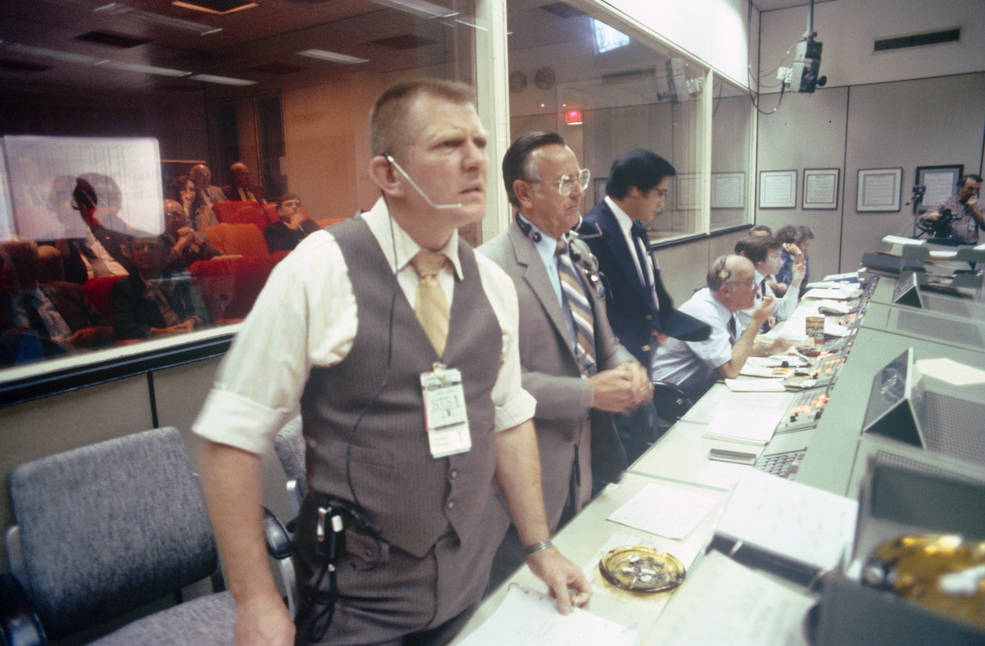
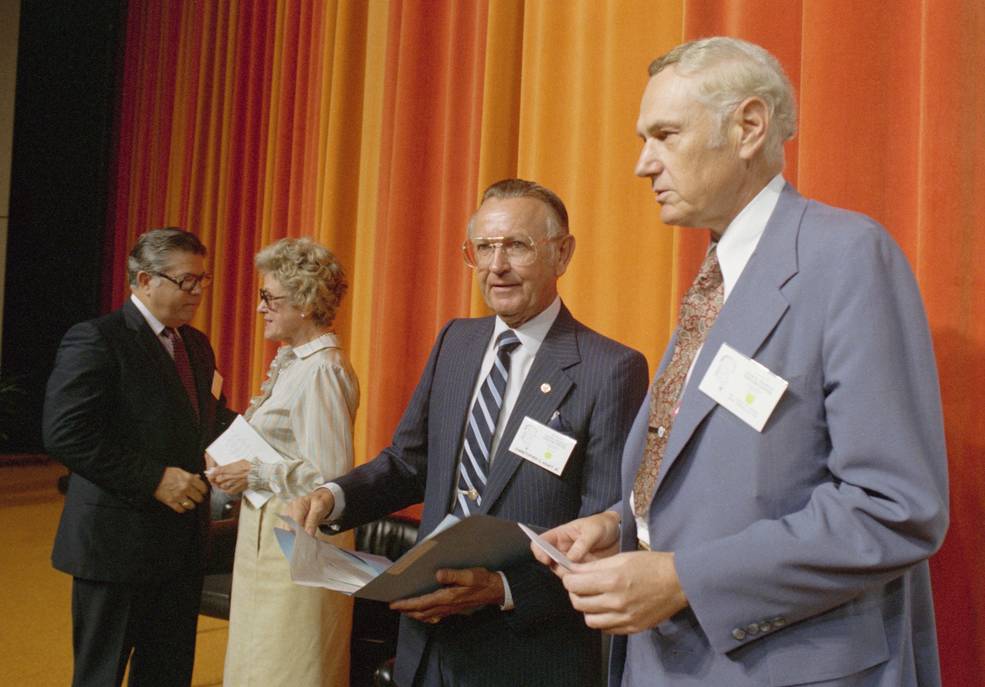
Left: In the Mission Operations Control Room of NASA’s Johnson Space Center (JSC) in Houston, CenterDirector Christopher C. Kraft, second from left, during STS-1, the first flight of the reusable space shuttle, in April 1981. Right: In July 1981, Kraft, second from right, with NASA Administrator James M. Beggs, right, at the ceremony that named JSC’s main auditorium after the late Texas Congressman Olin E. “Tiger” Teague.
After years of preparation, space shuttle Columbia lifted off on April 12, 1981, and returned to Earth two days later, successfully completing the STS-1 mission and ushering in the era of reusable spacecraft. Although no longer part of the operations team, Kraft still enjoyed spending time in Mission Control, observing the flight from the management consoles.
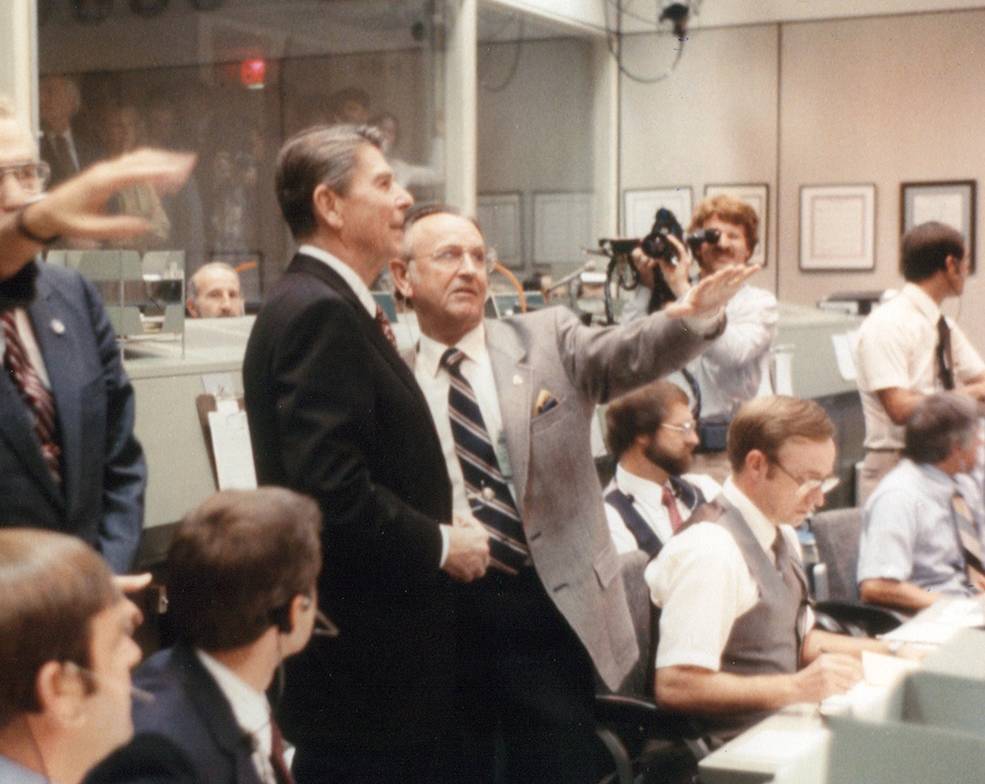
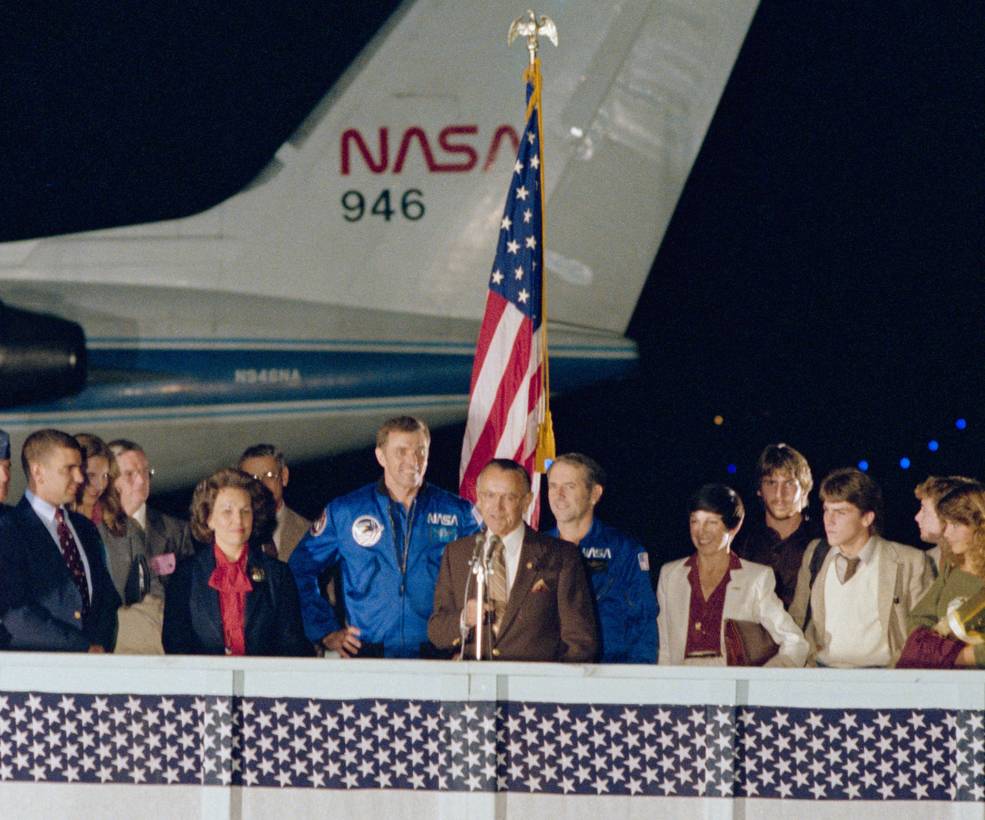
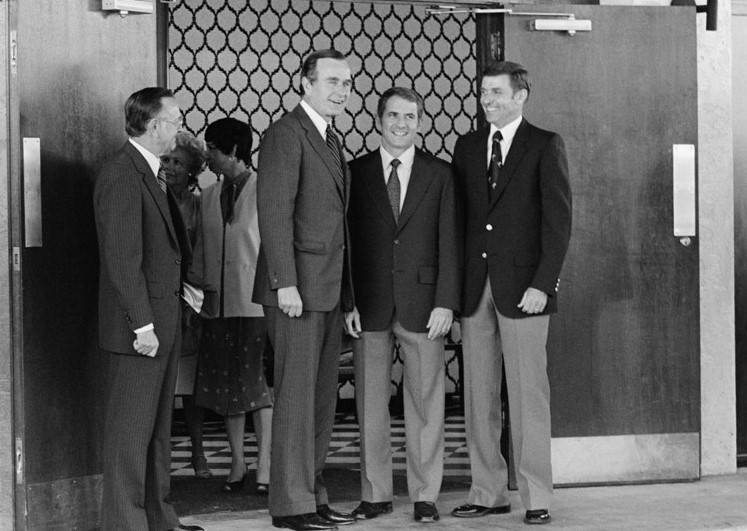
Left: In November 1982, during the STS-2 mission, Johnson Space Center (JSC) Director Christopher C. Kraft describes the Mission Operations Control Room to President Ronald W. Reagan during his visit to JSC. Middle: The following day, Kraft, center, welcomes STS-2 astronauts Joe H. Engle and Richard H. Truly back to Houston at Ellington Air Force Base. Right: And the day after that, Kraft, left, stands with Vice President George H.W. Bush to welcome Truly and Engle home at JSC’s Gilruth Center.
In association with the STS-2 mission in November 1982, Kraft hosted the first ever back-to-back visits by the nation’s two top executives. President Ronald W. Reagan visited during the mission’s second day in space, and Kraft toured him through the MCC, where Reagan had an opportunity to speak with Richard H. Truly and Joe H. Engle aboard Columbia. The next day, Kraft welcomed Truly and Engle back to Houston at Ellington Air Force Base, and the day after that, he hosted Vice President George H.W. Bush, who had breakfast with the newly-returned crew at the Gilruth recreation center.
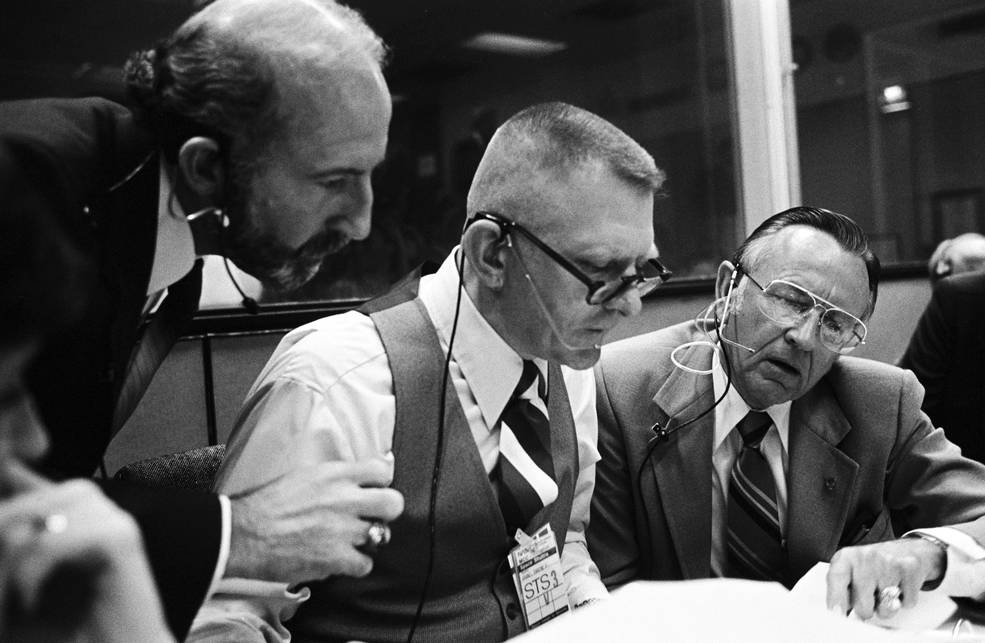
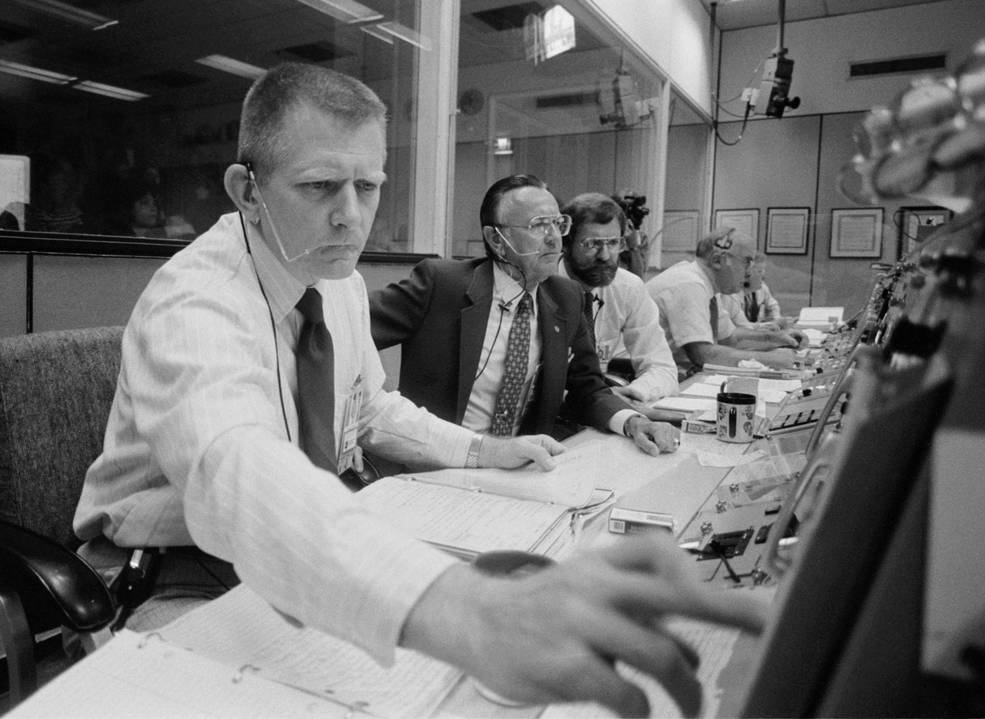
Left: In March 1982, in Johnson Space Center’s Mission Operations Control Room (MOCR), Center Director Christopher C. Kraft, right, reviews data with Thomas L. Moser, left, and Eugene F. Kranz, during the STS-3 mission. Right: In June 1982, Kraft, second from left, in the MOCR during the first day of the STS-4 mission with Kranz, left, and Flight Director Neil B. Hutchinson.
In his last year as center director, Kraft oversaw the final two orbital flight tests of the shuttle program, STS-3 and STS-4, in March and June-July 1982, respectively. In August, Kraft announced his retirement, ending an illustrious 37-year career with NACA and NASA, the last 10 as JSC’s center director. His legacy lives on, as NASA named the MCC he created after him during a ceremony on April 14, 2011. Kraft passed away on July 22, 2019, at the age of 95, two days after the 50th anniversary of the Apollo 11 Moon landing.
Gerald D. Griffin (August 1982 to January 1986)
Gerald D. Griffin joined MSC in 1964 as a flight controller in the MCC, specializing in Gemini and Apollo guidance, navigation, and control systems. Named as a flight director in 1968, Griffin led his Gold Team of controllers during all crewed Apollo missions, including the Moon landing phases of Apollo 14, 16, and 17. After the Apollo Program, Griffin relocated to NASA Headquarters in Washington, D.C., serving in legislative affairs, before becoming the deputy director at NASA’s Dryden (now Armstrong) Flight Research Center in California and then deputy director at NASA’s Kennedy Space Center in Florida. He returned to JSC in August 1982 to serve as the center’s third director following Kraft’s retirement.
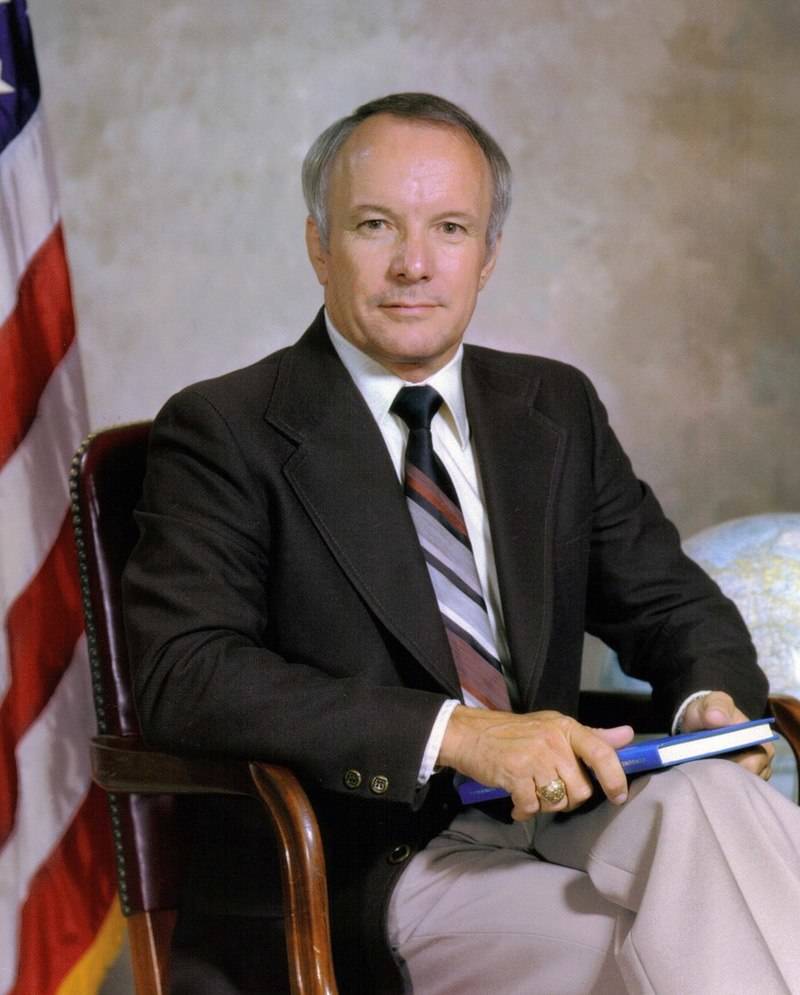
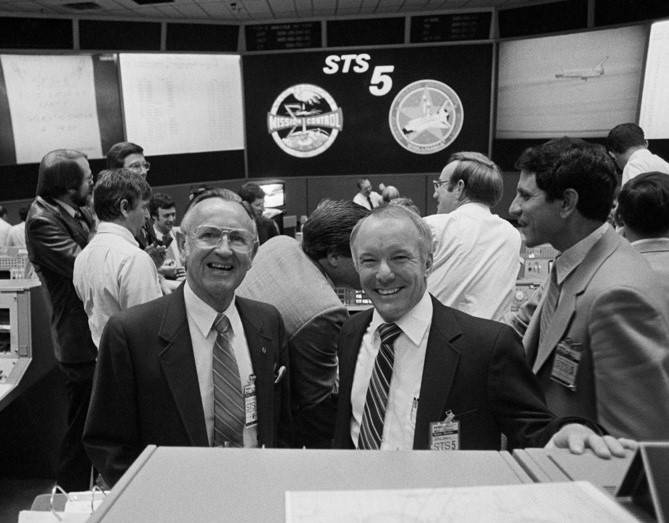
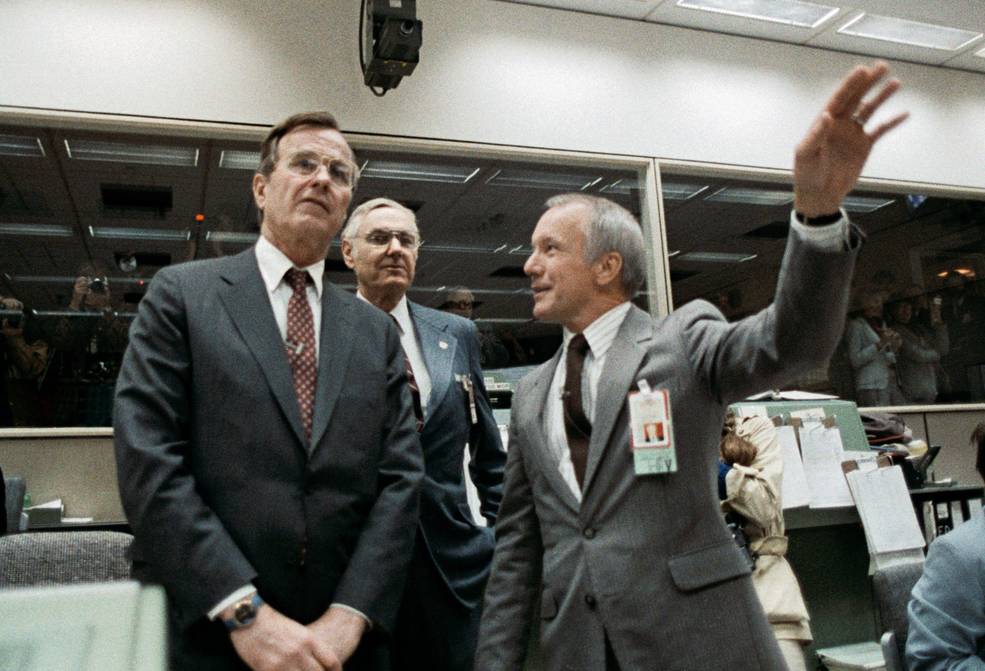
Left: Official portrait of Gerald D. Griffin, the third director of NASA’s Johnson Space Center (JSC) in Houston. Middle: Griffin, with former JSC Center Director Christopher C. Kraft, in the Mission Control Center at the conclusion of the STS-5 mission in November 1982. Right: Griffin explaining the functions of the Mission Control Operations Room to Vice President George H.W. Bush during his visit to JSC in April 1983 during the STS-6 mission.
Griffin introduced a management reorganization at JSC effective in April 1983 to better support the center’s changing focus from a center dedicated to space shuttle development to a center of space transportation system operations. He named Robert C. Goetz as deputy center director effective July 1, 1983. During Griffin’s tenure as center director, he oversaw 20 space shuttle flights, beginning with STS-5, the first mission to deploy commercial satellites. Significant firsts during the 20 missions included the first four-person, five-person, six-person, seven-person, and eight-person crew; the first American woman, the first African-American, the first Asian-American, the first Hispanic–American in space, and the first non-American on a space shuttle; the first spacewalk by an American woman; the first satellite retrieval; the first untethered spacewalk; and the first Spacelab mission. During this time, NASA selected 30 new astronauts in two classes in 1984 and 1985. The orbiters Challenger, Discovery, and Atlantis joined Columbia to round out the space shuttle fleet.
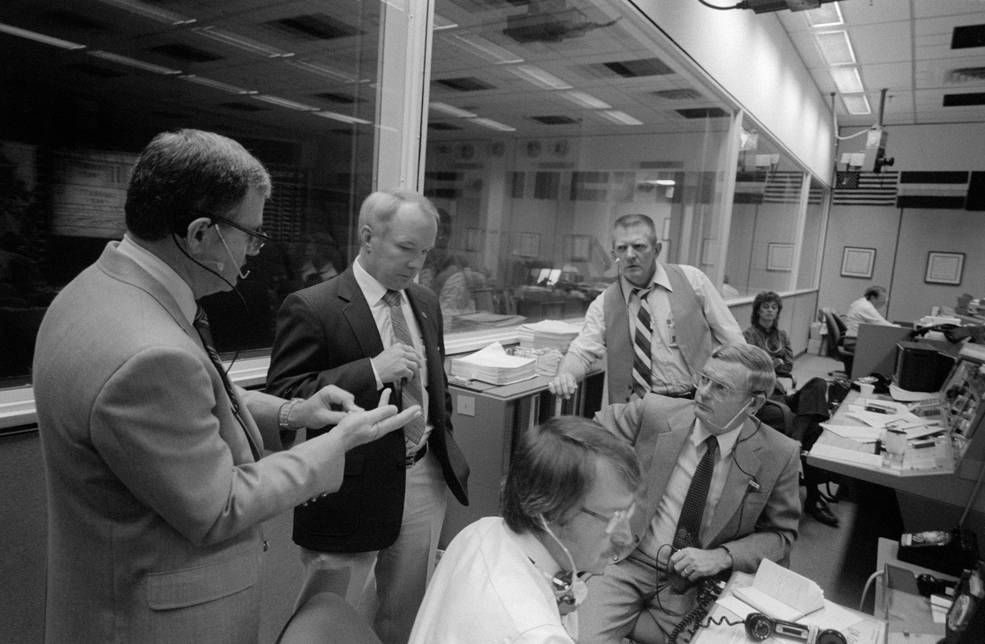
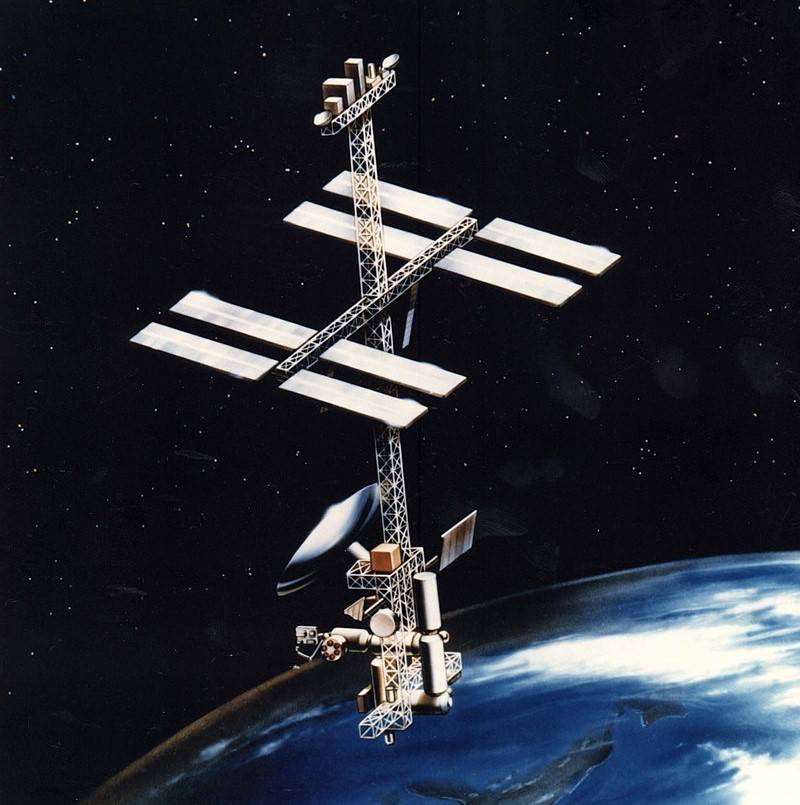
Left: Gerald D. Griffin, Director of NASA’s Johnson Space Center in Houston in the Mission Control Center during the STS-9/Spacelab-1 mission in December 1983. Right: Illustration of the proposed Power Tower configuration for the space station in 1984.
During his January 1984 State of the Union address, President Reagan directed NASA to develop a crewed Earth orbiting space station within a decade. With JSC named to lead the space station effort, Griffin established the Space Station Program Office in April 1984, with Neil B. Hutchinson as program manager. The space station, at the time proposed in a power tower configuration, was envisioned as an international project, with participation by Europe, Japan, and Canada.
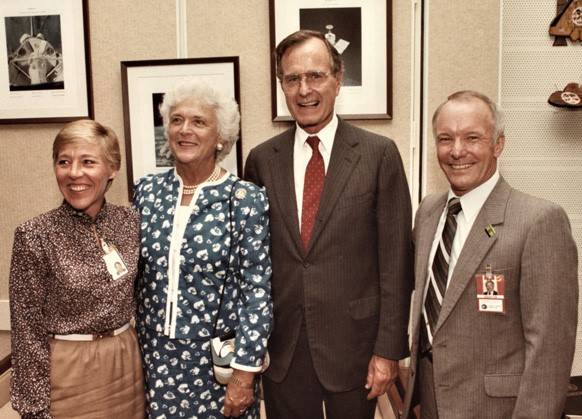
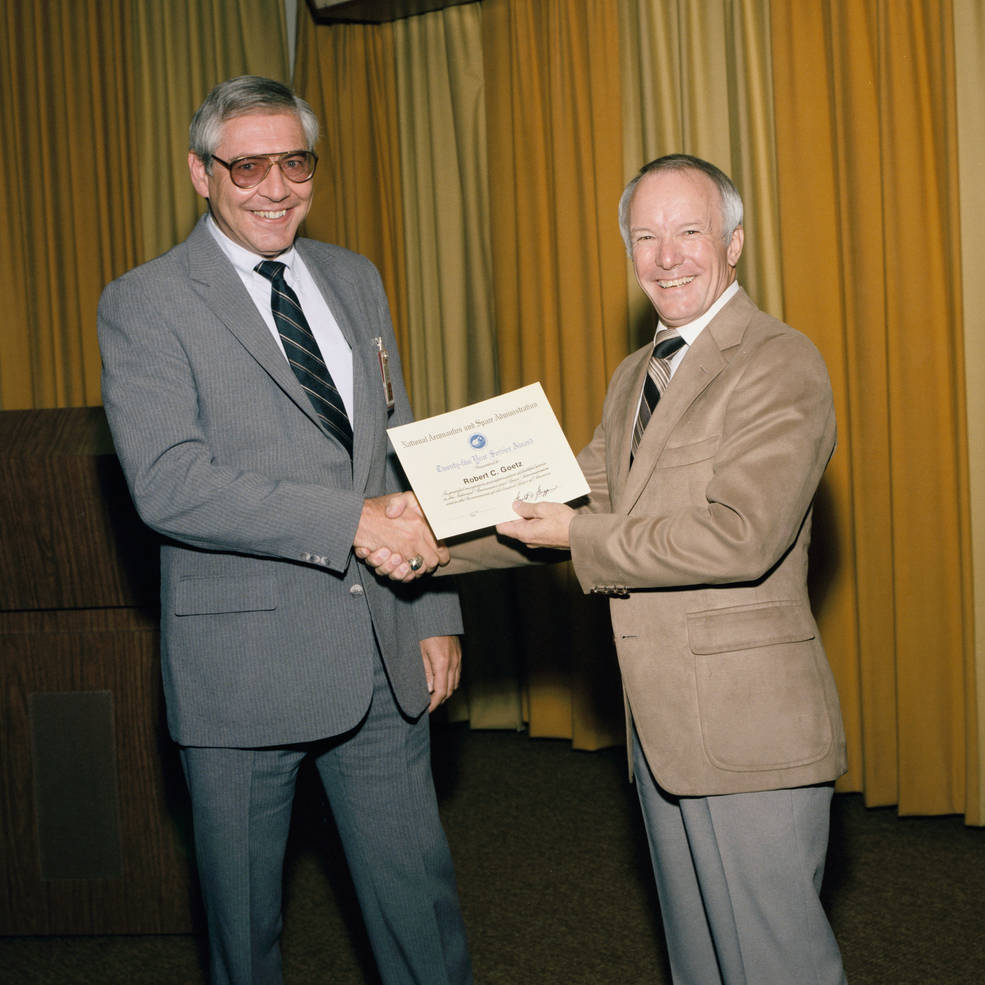
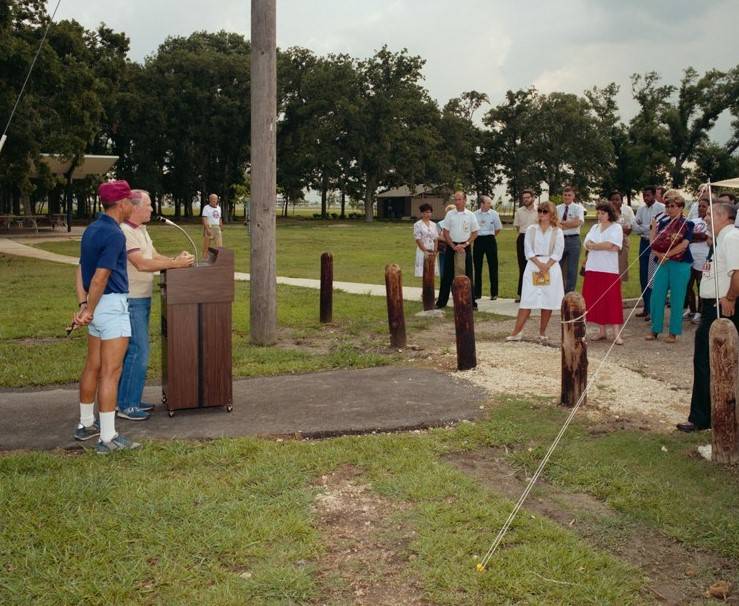
Left: Director of NASA’s Johnson Space Center (JSC) in Houston Gerald D. Griffin, right, with Vice President George H.W. Bush and First Lady Barbara Bush in August 1984 during the STS-41D mission. Middle: Griffin, right, presenting JSC Deputy Center Director Robert C. Goetz, with a 25-year service award in October 1984. Right: In June 1985, Griffin, at podium, officiating at the ribbon-cutting ceremony for the new half-mile running track at the Gilruth Recreation Center.
Griffin took early retirement from NASA, leaving JSC on Jan. 15, 1986, during the STS-61C mission and just two weeks before the space shuttle Challenger accident. He left to head the Houston Chamber of Commerce as its president. Deputy director Goetz served as acting center director until the next director relocated from NASA Headquarters. Griffin remained involved in the space business for many years after his retirement from NASA.
Jesse W. Moore (January 1986 to October 1986)
Jesse W. Moore joined NASA in 1966 at the Jet Propulsion Laboratory in Pasadena, California, first working on guidance systems for U.S. Navy missiles and later as design manager for the Galileo mission to Jupiter. He transferred to NASA Headquarters in 1978 as deputy director of the Solar Terrestrial Division in the Office of Space Science. Three years later he was appointed as director of the Earth and Planetary Exploration Division and in 1984 as associate administrator for space flight. On Jan. 23, 1986, Moore was named to succeed Griffin as JSC’s fourth director. Deputy center director Goetz served in an acting capacity until Moore could relocate to Houston, which at the time was not expected until May, during which time Moore would continue as associate administrator for space flight. In that role, Moore chaired the flight readiness review and the mission management team meetings that cleared Challenger for flight on the STS-51L mission.
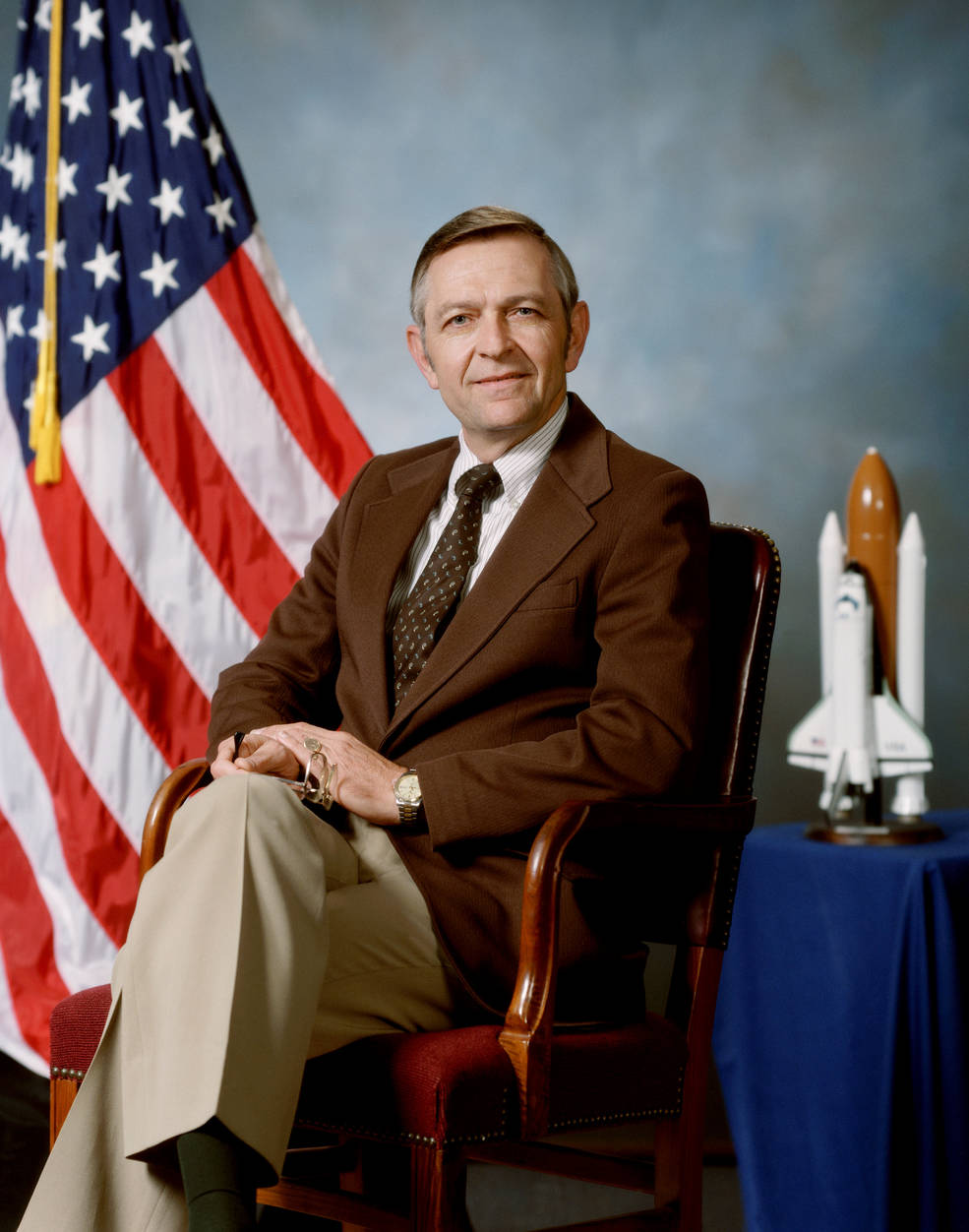
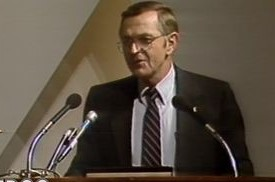
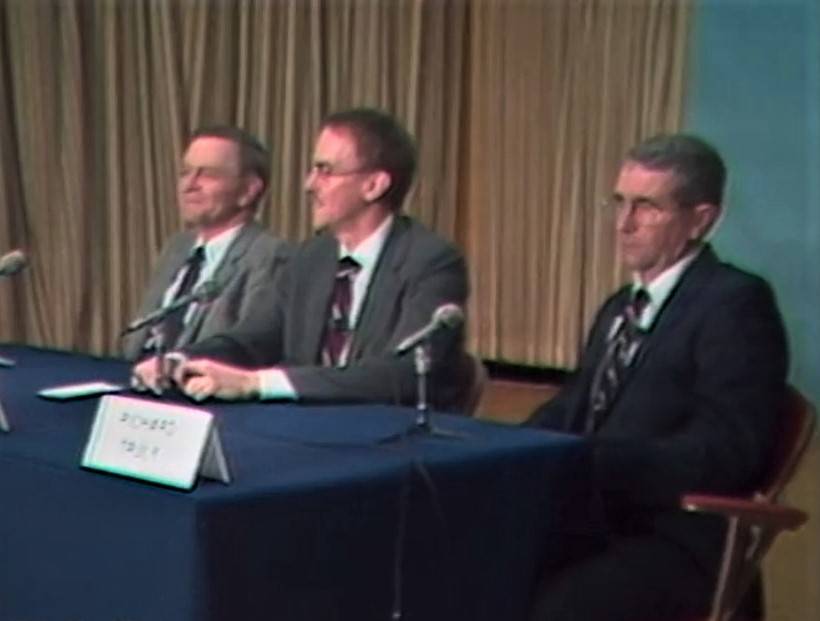
Left: Official portrait of Jesse W. Moore, the fourth director of NASA Johnson Space Center (JSC). Middle: Moore testifying before the Presidential Commission on the Space Shuttle Challenger Accident in February 1986. Right: Moore, left, acting NASA Administrator William R. Graham, and newly appointed Associate Administrator for Space Flight Richard H. Truly.
The Challenger accident that claimed the lives of its seven crew members happened just five days after Moore was named JSC director. Because of his role in approving the launch of the STS-51L mission, Moore testified before the Presidential Commission on the Space Shuttle Challenger Accident, known as the Rogers Commission after its chair, former Secretary of State William P. Rogers, on Feb. 6, 1986. On Feb. 25, Acting NASA Administrator William R. Graham named Richard H. Truly to succeed Moore as associate administrator for space flight so Moore could concentrate on his role as JSC director. Three days later, in his first official duty as JSC director, Moore addressed center employees in the aftermath of the accident, saying, “We will continue with a renewed spirit and a strengthened sense of purpose.” On March 25, in an address at JSC Moore and Truly announced NASA’s post-Challenger recovery plan to fully understand the causes of the accident, both technical and organizational, correct any identified problems, and return the space shuttle to flight as soon as it was safe to do so.
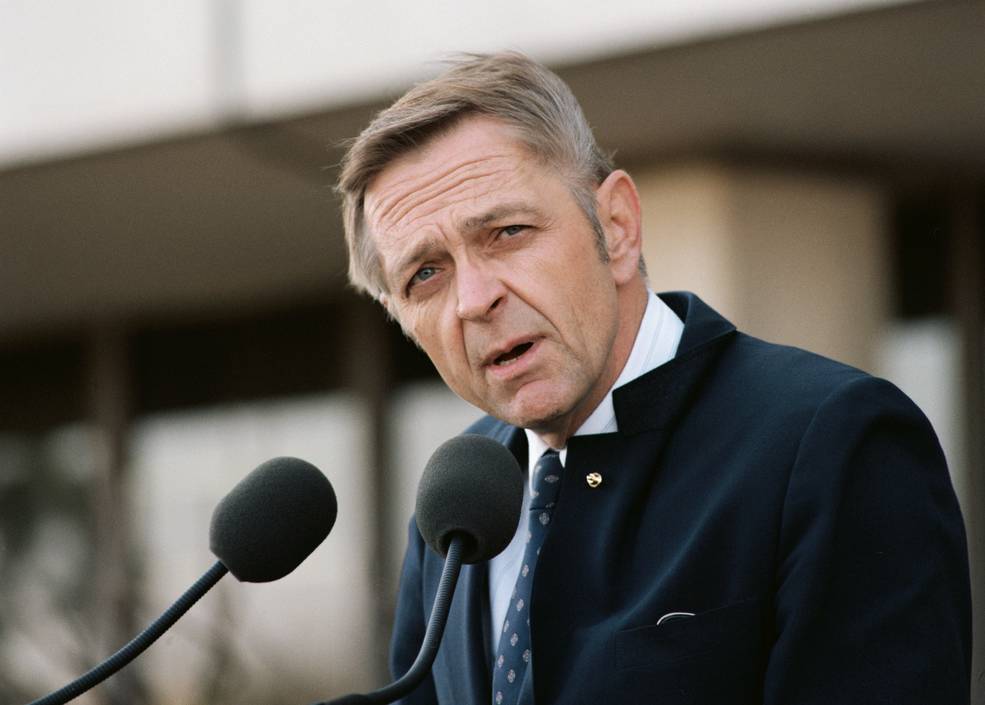
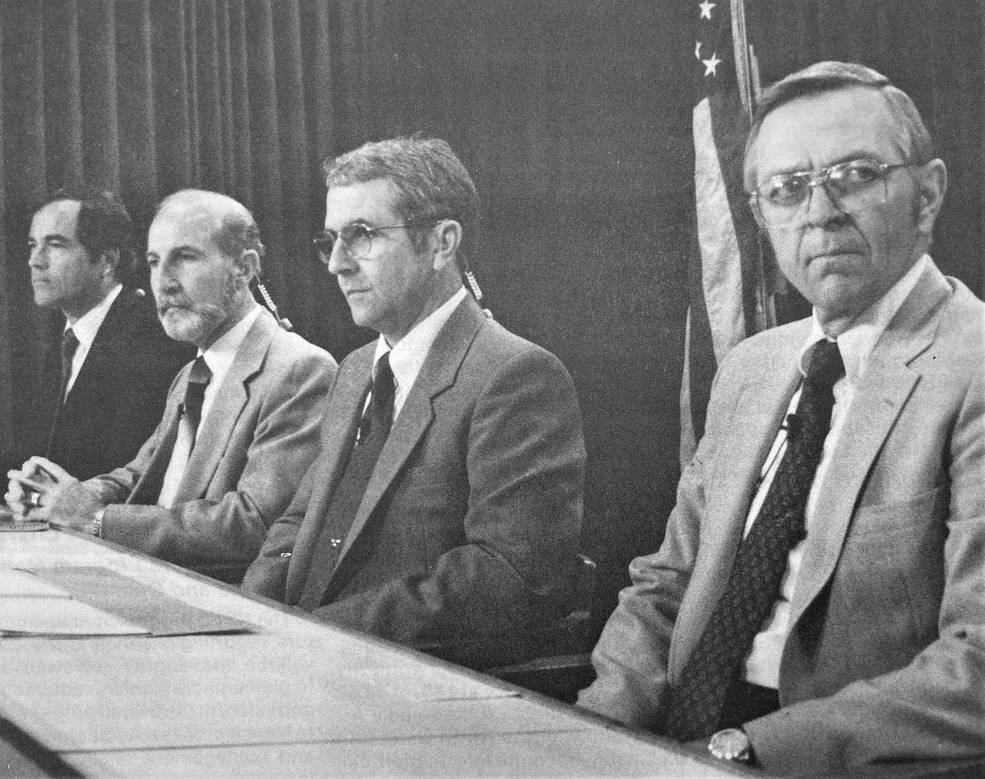
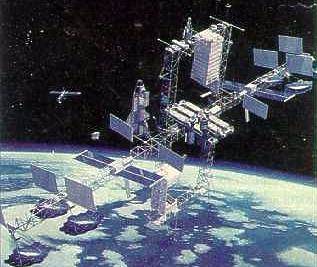
Left: Director of NASA’s Johnson Space Center Jesse W. Moore speaking to JSC employees one month after the Challenger accident. Middle: Moore, right, during a March 1986 press conference with Deputy Director of Flight Crew Operations Robert L. Crippen, Deputy Associate Administrator for Space Flight Thomas L. Moser, and Associate Administrator for Space Flight Richard H. Truly discussing NASA’s post-Challenger recovery plans. Right: Illustration of the space station dual-keel configuration adopted by NASA in May 1986.
Development of the space station program progressed during Moore’s tenure. On May 14, just two days after being sworn in, NASA Administrator James C. Fletcher announced the approval of the dual-keel configuration for the space station, with first element launch then expected in 1993. NASA reached preliminary agreements with Canada and Japan in March and with the European Space Agency (ESA) in August regarding their contributions to the project. Japan and ESA would each contribute a pressurized research module while Canadian contributions would involve robotic systems based on the Remote Manipulator System they provided for the space shuttle. At JSC, construction began on Building 9B, an extension on the northwest side of the existing facility, to house space station training mockups.
On Oct. 2, 1986, NASA Administrator Fletcher announced Moore’s reassignment at his request to NASA Headquarters as special assistant to the general manager effective on Oct. 12, 1986. Fletcher named Aaron Cohen, JSC’s director of research and engineering, to succeed Moore as the center’s fifth director. Moore resigned from NASA in February 1987 to become the director of program development at Ball Aerospace Systems in Boulder, Colorado.
The next installment in this series will cover JSC’s next three directors in the 1980s and 1990s, from the space shuttle’s return to flight after the Challenger accident to the first launches of the International Space Station and into the new millennium.
John Uri
NASA Johnson Space Center








